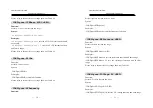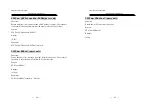
GDM-8246 MULTIMETER
PROGRAMMER MANUAL
⎯
50
⎯
Status Registers
There are two status registers are included to the DMM defined by
IEEE-488.1 and IEEE-488.2 standards.
z
Status Byte Register (SBR)
z
Standard Event Status Register (SESR)
Status Byte Register (SBR)
: The SBR (Table 6) summarizes the status of
all other registers and queues.
Table 6: Status Byte Register (SBR)
Bit 7
Bit 6
Bit 5 Bit 4 Bit 3 Bit 2
Bit 1
Bit 0
OPER RQS/MSS ESB MAV QUES
E/E
NU
NU
The bit 0 and 1 are not used, so these bits are always zero. The bit 2
(Error and Event) indicates an error code is waiting to be read in the
Error Event Queue. The bit 3 (QUES, QUEStionable) is the summary bit
for the QESR (QUEStionable Event Status Register). When the bit is
high it indicates that status is enabled and present in the QUES. The bit 4
(MAV, Message Available) indicates that output is available in the
output queue. The bit 5 (ESB, Event Status Bit) is the summary bit for
the Standard Event Status Register (SESR). When the bit is high it
indicates that status is enabled and present in the SESR. The bit 6 (RQS,
Request Service) is obtained from a serial poll and shows that the DMM
requests service from the GPIB controller. The bit 7 (OPER, OPERation)
is the summary bit for the OESR (OPERation EVENt STATus Register).
GDM-8246 MULTIMETER
PROGRAMMER MANUAL
⎯
51
⎯
Use the serial poll or the
*STB?
Query to read the contents of the SBR.
The bits in the SBR are set and cleared depending on the contents of the
Standard Event Status Register (SESR), the Standard Event Status
Register (SESR), and the Output Queue.
Standard Event Status Register (SESR)
: Table 7 shows the SESR
Table 7: Standard Event Status Register (SESR)
Bit 7
Bit 6
Bit 5
Bit 4
Bit 3
Bit 2
Bit 1
Bit 0
PON URQ CME EXE DDE QYE NU OPC
The bit 0 (OPC, Operation Complete) shows that the operation is
completed. This bit is active when all pending operations are completed
following an
*OPC
command. The bit 1 is always zero. The bit 2 (QYE,
Query Error) indicates a command or query protocol error. The bit 3
(DDE, Device Error) shows that a device error occurred. The bit 4 (EXE,
Execution Error) shows that an error occurred while the DMM was
executing a command or query. The bit 5 (CME, Command Error) shows
that an error occurred while the DMM was parsing a command or query.
The bit 6 (USR, User Request) indicates the LOCAL button was pushed.
The bit 7 (PON, Power On) shows that the DMM was powered on.
Use the *ESR? Query to read the SESR. Read the SESR and clear the
bits of the registers so that the register can accumulate information about
new events.
Enable Registers
The enable registers determine whether certain events are reported to the
Status Byte Register and SRQ. The Digital Multimeter has the following
enable registers.



































